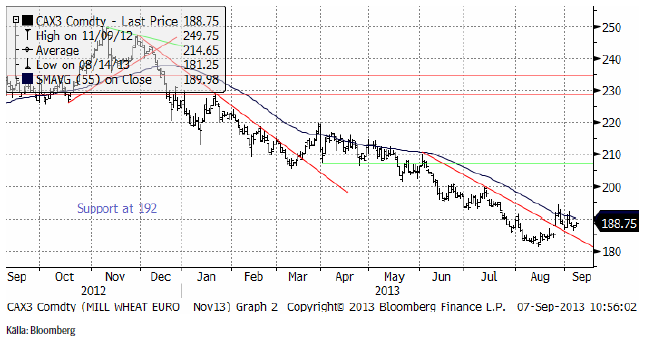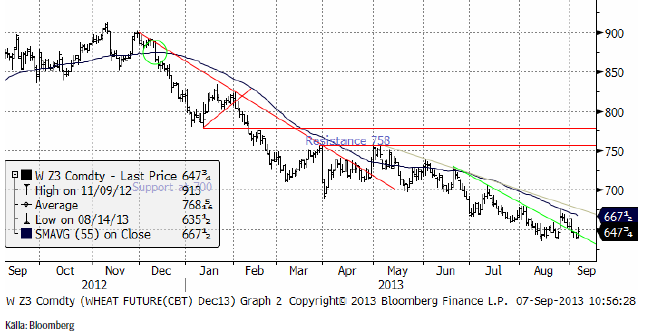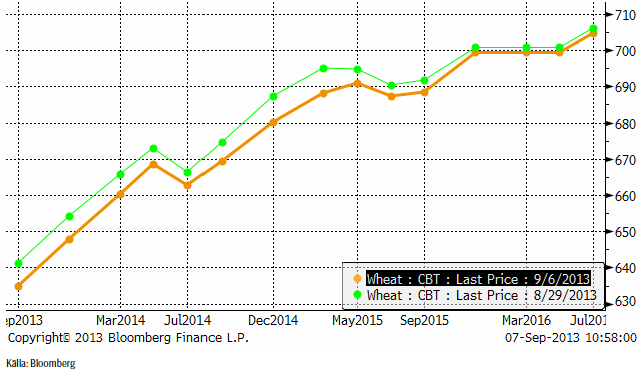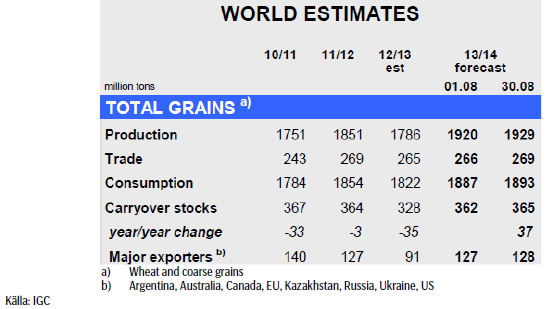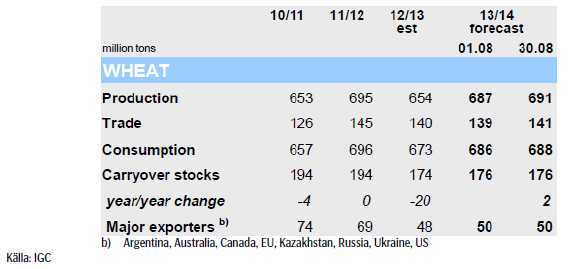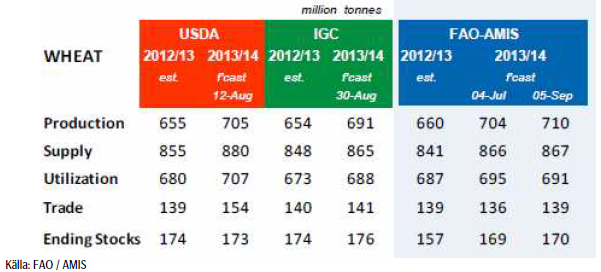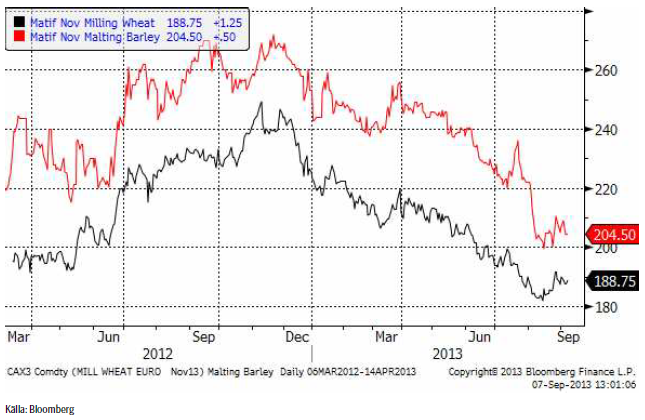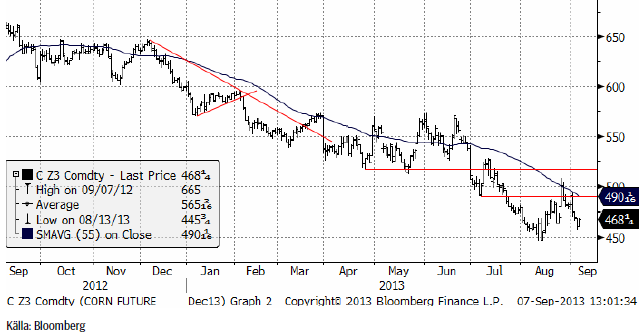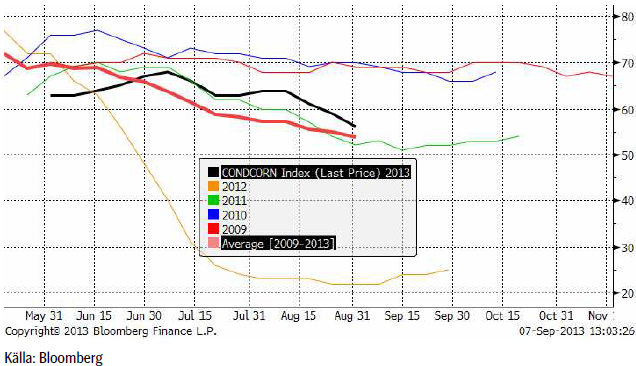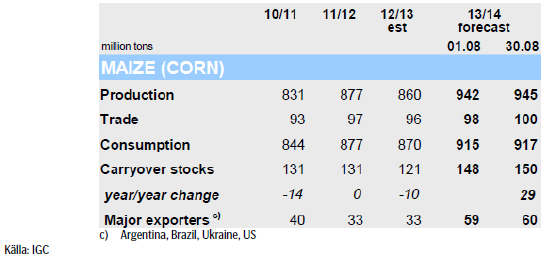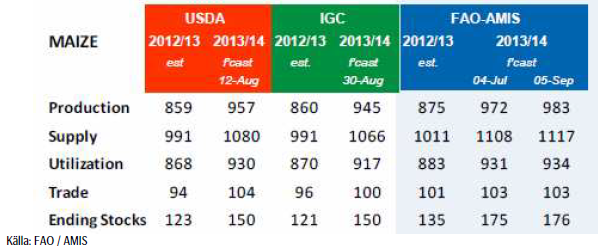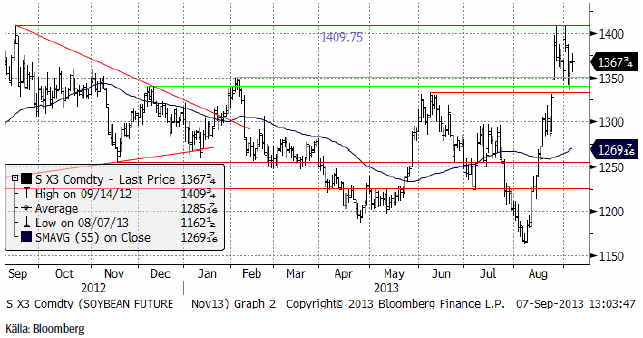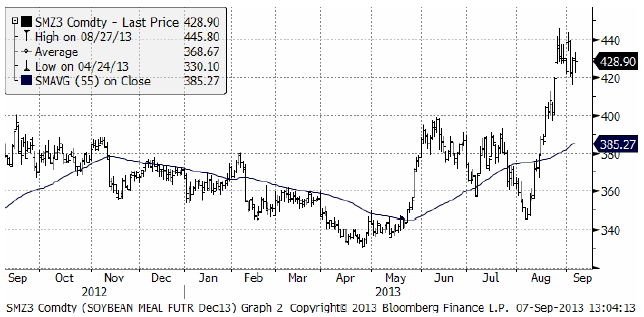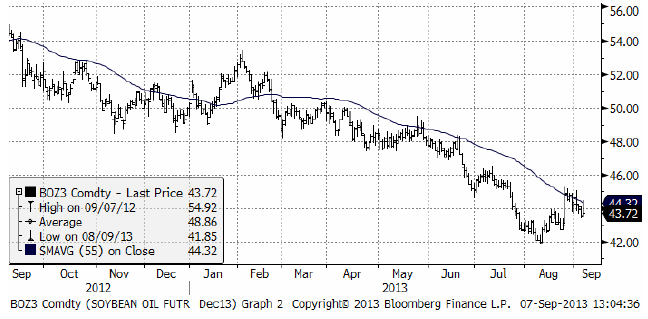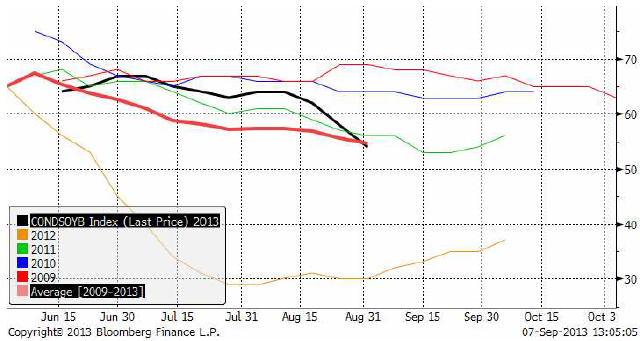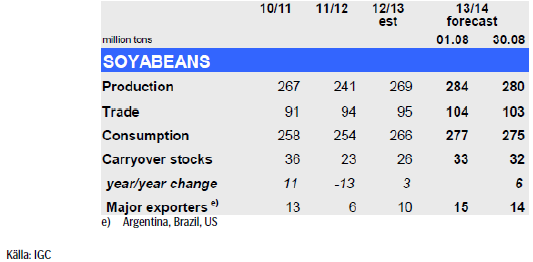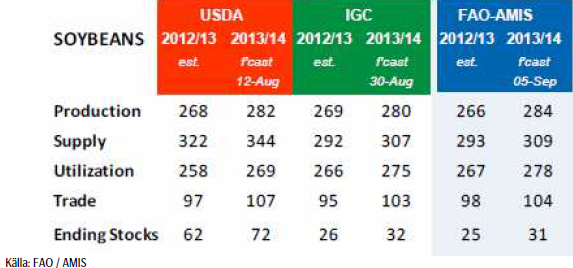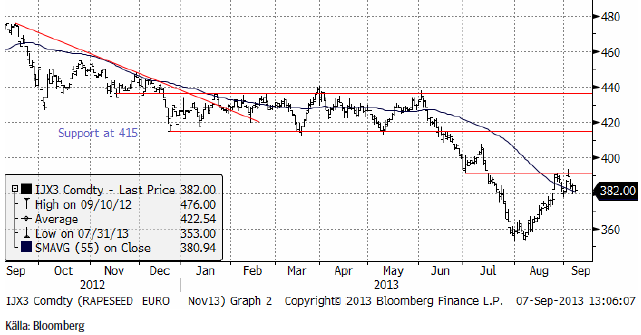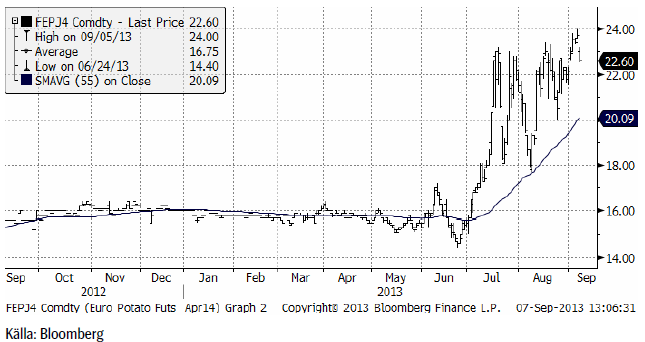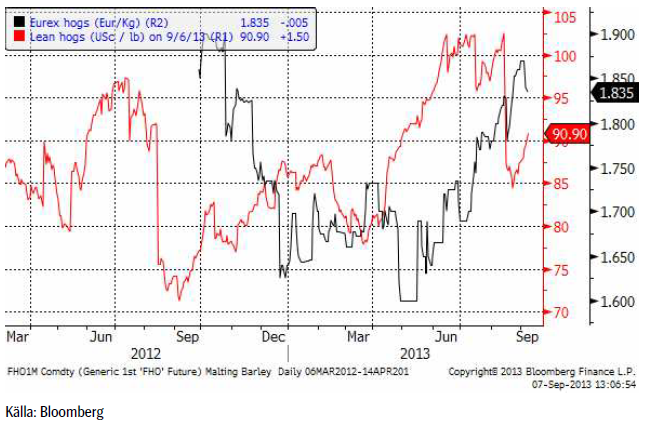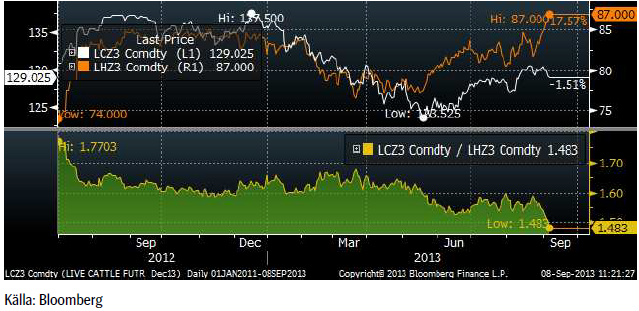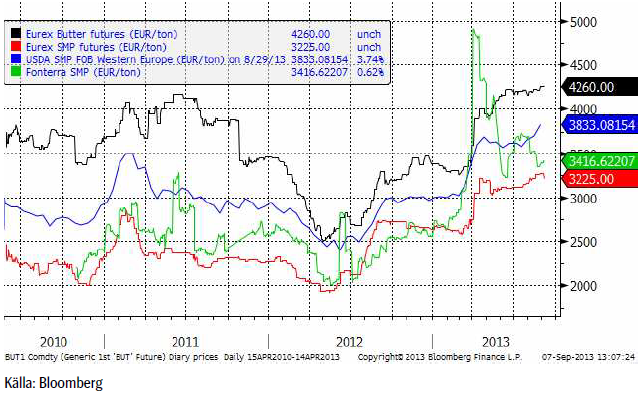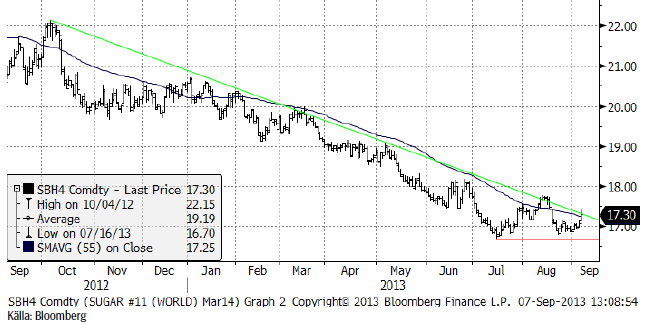Analys
SEB Jordbruksprodukter, 9 september 2013
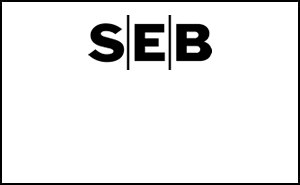

 Vetemarknaden ligger och driver i nyhetsmässig stiltje. Majs- och i synnerhet sojamarknaden håller på att lämna ett år med låga lager och gå över till ett år med väsentligt högre produktion. Ännu finns dock inga riktigt tillförlitliga estimat på skördens storlek i USA och hur torkan i augusti har påverkat den.
Vetemarknaden ligger och driver i nyhetsmässig stiltje. Majs- och i synnerhet sojamarknaden håller på att lämna ett år med låga lager och gå över till ett år med väsentligt högre produktion. Ännu finns dock inga riktigt tillförlitliga estimat på skördens storlek i USA och hur torkan i augusti har påverkat den.
På torsdag kommer dock september månads WASDE-rapport och den kan ge viss vägledning. Redan den 17 september publicerar FAS en rapport på arealen och den kan också ge viktig vägledning för marknaden. Vi har sammanställt analytikerkårens estimat på WASDE-rapporten och du ser den nedan:
Vete
November vetet på Matif höll sig över stödlinjen, men backade större delen av veckan. I EU trycker fortfarande lantbrukarna på sin fysiska spannmål.
Decemberkontraktet på CBOT tycks ha ett stöd strax under dagens pris. Stödet ligger vid 640 cent ungefär. Priset studsade upp från den nivån mot slutet av veckan.
Nedan ser vi terminskurvorna för Chicagovete. Det är den enda marknad som det är intressant att sälja långa terminer på, eftersom det är contango och nästan alltid är det.
Dessutom ser utvecklingen i EU:s nya lagförslag om värdepappersmarknaden, Mifid 2 och Mifir ut att slå hårt mot Matif som marknadsplats. Lagförslaget kommer att göra det så dyrt att handla terminer inom EU att Matif omöjligen kommer att kunna stå sig i konkurrensen med de amerikanska börserna.
Tisdagens Crop Progress från USDA visar att skörden av amerikanskt vårvete fortsätter att avancera i raskt takt. För de 6 stater som rapporterar så är nu 64% av skörden avklarad, en ökning från förra veckans 42% men något under det 5-åriga genomsnittet på 69% och väl under förra årets 93% vid den här tiden.
70% klassas som ”good/excellent”, en ökning från förra veckans 67%.
Egypten har köpt ytterligare 355 000 ton vete för leverans i början av oktober, vilket gör att totalen för den veckan uppgår till 650 000 t. Ungefär samma fördelning som förra gången med 180 000 t ryskt vete, 120 000 t rumänskt vete och resten från Ukraina. Det franska vete som offererades ligger fortfarande över i pris, dock något lägre än förra tendern. Inga offerter lämnades för amerikanskt vete.
Den ryska regeringen uppger att det kan vara svårt att hålla fast vid en exportsiffra på 18-20 mt för 2013/14 på grund av hög produktion i länderna kring Svarta Havet och deras konkurrens på den internationella marknaden.
Buenos Aires Grain Exchange rapporterade i veckan att den 45% av vete är i mycket bra kondition, men att veteområdena var torra. De sade också att 90% av kornarealen var i gott eller väldigt gott skick.
IGC (International Grains Council) kom med sin rapport i förra veckan och har ökat sitt estimat för den globala spannmålsproduktionen 2013/14 med 9 mt till 1929 mt. Stora skördar av bl.a vete och majs bidrar till en förväntad ökning med 8% på årsbasis från 2012 års produktion då torka drabbade stor del av grödorna. Utgående lager förväntas öka med 37 mt på årsbasis till 365 mt, vilket framförallt återspeglar högre utgående lager för majs (+29 mt y/y).
För vete indikeras en global produktion på 691 mt, vilket börjar närma sig rekordnivån under 2011/12, som en följd av uppjusteringar för EU, Kazakstan, Ukraina och Kanada. Den stabila efterfrågan på vete, delvis på grund av kvalitetsproblem i Kina, har gett fortsatt stöd åt priserna. Dock förväntas en marginell ökning av utgående lager 2013/14, som nu estimeras till 176 mt – inklusive en viss återhämtning hos de stora exportörerna. Utgående lager i USA förväntas däremot sjunka till den lägsta nivån på 6 år (15 mt).
Även FAO / AMIS kom med sin rapport nu i veckan och de har justerat upp sin prognos för den globala veteproduktionen 2013/14 med 6 mt till 710 mt, som en följd av förbättrade utsikter i EU och OSS samt mer gynnsamma utsikter i Australien, Argentina och Kanada. Utgående lager beräknas öka med ca 8%, där merparten är koncentrerad till EU, Kina och OSS-länderna. Utsikterna är gynnsamma på det norra halvklotet där skörden av höstvete nu är avklarad och där skörden av vårvete påbörjats. USA, Kanada, Ryssland och Kazakstan visar på goda prognoser för vårvete, men den slutliga avkastningen kommer att vara beroende av gynnsamt väder under den kommande månaden. Samma sak gäller för södra halvklotet där t.ex Australiens grödor är i stort behov av regn den närmsta tiden då det finns en viss oro över torkan i delar av landet. Även Argentina är i behov av mer nederbörd. I Brasilien har frost orsakat betydande skador på sina ställen.
Maltkorn
Maltkornet rekylerade uppåt samtidigt med vetet och oljeväxterna. För maltkornet fanns (och finns) ett starkt stöd vid 200 euro. Jämna siffror tenderar att attrahera köp-ordrar när priset kommer farande uppifrån. Den senaste veckan har maltkornet utvecklats svagare än vetet på Matif.
Majs
Majspriset (december 2013) föll tillbaka i veckan som gick och befinner sig alltjämt i negativ trend. Tidiga skörderapporter från södra USA visar på högre avkastning än väntat. Etanolefterfrågan har planat ut. Kinas CNGOIC nämnde dock i veckan en importpotential om 20 – 30 mt.
Tisdagens Crop Progress från USDA gav fortsatta nedjusteringar gällande tillståndet för den amerikanska majsen. För de 18 stater som rapporterar så klassas nu 56% som ”good/excellent”, ner 3% från veckan innan men fortfarande över förra årets torka-drabbade 22% samt över det 5-åriga genomsnittet på 55%. I Iowa tillhör endast 39% av grödorna kategorin ”good/excellent”, medan omkring 57% respektive 66% tillhör denna kategori i Illinois och Indiana. Siffran för ”good/excellent” i Indiana och Iowa har justeras ned med 6% respektive 5% från veckan innan.
Andelen majs som har uppnått mjölmognad uppgår till 42%, en ökning från förra veckans 23%. Förra året under torkan så låg siffran på 84% vid den här tiden, men det 5-åriga genomsnittet för samma datum ligger på 61%. Runt 46% av grödorna i Illinois har nått detta utvecklingsstadium, en ökning från 29%, medan siffran för Indiana ligger på 47%, upp från 22% veckan innan.
Informa Economics Inc, en analysfirma baserad i Tennessee, skrev i en rapport i fredags att de väntar sig att global majsproduktion kommer att uppgå till 955 mt under 2013/14. De sänkte därmed sitt estimat från 957.7 mt, som de publicerade förra månaden.
IGC rapporterade i veckan som gick. Den globala produktionen av majs beräknas uppgå till 945 mt, en ökning med 3 mt sedan IGC’s förra rapport och en ökning med 10% på årsbasis. Revideringen sker trots en förväntad lägre produktion i Sydamerika, vilket istället gynnar sojabönor, men baseras på högre produktion i USA.
FAO justerar upp estimatet för den globala produktionen av majs till 983 mt från den tidigare prognosen på 972 mt, främst på grund av större skördar i Argentina och förbättrade utsikter för EU och Ukraina. Utgående lager beräknas öka med 30% från ingående lager, och USA står för merparten av denna ökning där lagren kan komma att stiga med 27 mt eller 146%. Överlag är utsikterna för grödorna goda. I USA klassas cirka hälften som ”good/excellent, och trots torrt och varmt väder under augusti så förväntas en jätteskörd – till stor del på grund av utökad areal. Även i Kanada och EU är prognoserna gynnsamma, med undantag av bl.a norra Italien, Slovenien och Kroatien där sen sådd och varma temperaturer påverkat grödorna negativt. Även i övriga delar världen, såsom Ryssland, Kina, Ukraina och Brasilien är utsikterna goda.
Som nämnt ovan behåller vi alltså förra veckans neutral-rekommendation.
Sojabönor
Novemberkontraktet på sojabönor pendlade i veckan som gick mellan den tekniska stödnivån 1350 och det tekniska motståndet 1409 cent / bushel. Vi tror att uppgången är klar och att de som tror på nedgång har de starkare korten. Brasiliens skörd är nu bara 4 månader bort.
Informa Economics i Tennessee skickade ut sin senaste månatliga prognos på sojaskörden 2013/14 i fredags. Sedan förra månaden har de sänkt estimatet för global produktion från 288 mt till 285 mt. Det är en mycket marginell minskning.
Sojamarknaden är naturligt uppdelad på sojamjöl och sojaolja och det är två helt olika världar. Efterfrågan på sojamjöl är stark, medan världen har mer än nog av vegetabiliska oljor. Nedan ser vi prisutvecklingen på sojamjöl i dollar per short ton.
Och nedan ser vi den mycket baissigare utvecklingen på sojaoljan.
Tisdagens Crop Progress från USDA visade även på fortsatta nedjusteringar för sojabönor. 54% klassas nu som ”good/excellent”, ner från förra veckans 58% men fortfarande över förra årets 30% och genomsnittet på 55%. De senaste veckornas varma och torra väder har framförallt drabbat de stora producenterna i ”Istaterna” där andelen ”good/excellent” faller tillbaka med 5-8%, och det enbart under förra veckan. I Illinois och Indiana klassas 52% resp. 62% som ”good/excellent”, medan endast 39% av Iowas grödor tillhör denna kategori.
92% av sojabönorna har uppnått stadiet baljsättning, en ökning från förra veckans 84%. Förra året vid den här tiden låg siffran på 98% och det 5-åriga genomsnittet ligger på 96%.
IGC rapporterade i veckan som gick. För sojabönor förväntas en global produktion på rekordhöga 280 mt för 2013/14, en ökning med 4% på årsbasis, framförallt tack vare estimerade jätteskördar i Sydamerika. Produktionen i USA justeras ner från tidigare prognos på 93.1 mt till 88.6 mt, vilket fortfarande är en ökning med 8% på årsbasis och den högsta nivån sedan 2010/11. Globala lager kommer sannolikt att öka för andra året i rad. Den globala produktionen av raps / canola beräknas öka med 4% på årsbasis under 2013/14, samtidigt som utgående lager beräknas öka modest för första gången på 4 år.
Enligt FAO:s rapport visar tidiga indikationer på en rekordproduktion av sojabönor 2013/2014. Högre produktion i länder som Argentina, USA, Brasilien och Indien förväntas bidra till en global produktion på 284 mt. Även lagren förväntas öka ordentligt – framförallt i USA, Argentina och Brasilien. Utsikterna för grödorna är gynnsamma, även om den långvariga torkan i den amerikanska Mellanvästern skapar oro så klassas fortfarande ungefär hälften som ”good/excellent”. I Kina är förutsättningarna goda i de norra och nordöstra delarna av landet och även i Indien finns det goda förutsättningar, trots en viss oro över alltför mycket blöta.
Raps
Rapspriset rekylerade ner mot 380 euro under veckan, efter att motståndet vid 392 euro höll.
Vi tror att det kan komma en sväng nedåt, under 380 euro per ton och behåller säljrekommendation på raps.
Potatis
Potatispriset har fortsätt att ligga vid 22 euro per 100 Kg på Eurexbörsen.
Gris
Eurexpriset rekylerade ner i veckan som gick, medan amerikanska Lean Hogs fortsatte upp. Dyrt nötkött i USA, väntas medföra att fler väljer fläsk.
Lean Hogs har gått upp i pris mycket mer än Live Cattle. Nedan ser i kvoten mellan priset på decemberkontrakten. Lean Hogs har utklassat Live Cattle i nästan två år. Lean Hogs är nu rekorddyrt i förhållande till Live Cattle (som dock ligger på en högre nivå, i absoluta pengar).
Mjölk
Terminerna på smör och skummjölkspulver vid Eurex-börsen har fortsatt att stiga i veckan som gick. Fonterras pris noterar också en liten uppgång. USDAs europeiska SMP-notering visar också på en uppgång och bekräftar den positiva utvecklingen på Eurex terminsmarknad.
Socker
Oktoberkontraktet på råsocker steg kraftigt mot slutet av veckan och testar nu motståndet för den fallande trenden från oktober förra året – se diagrammet nedan!
Bakom detta ligger en rapport från handelsföretaget Czarnikow i London. De sade i torsdags att överskottet i marknaden kan vara mycket mindre än vad folk tror. De menade att marknaden underskattar den stimulans till ökad konsumtion som de lägre priserna ger. De sänkte estimatet på överskottet till 2 mt nästa år (som börjar i oktober), från 3.9 mt.
The International Sugar Organization publicerade ett estimat för två veckor sedan på ett överskott på 4.5 mt, medan andra analytiker ligger på 4 mt i genomsnitt.
Czernikow nämner också att odlingen av betor dels kommer att bli mindre och att vädret i Europa inte gynnat betodlingen i år. De sänker också estimatet för produktionen i Brasilien med 10 mt till 585 mt, för Sudeste regionen, där man odlar sockerrör (delstaterna São Paulo, Paraná, Rio, Minas Gerais). Den regionen står för 90% av Brasiliens produktion.
Czarnikow höjer konsumtionstillväxten till 2.3% under 2013 och 2% nästa år. De menade att dessa estimat är konservativa. Det låga priset kan stimulera till högre konsumtionstillväxt än så.
De nämner också att sockerbruken i Brasilien som alltid betalar en cent under terminspriset på socker för inlevererade sockerrör vid skörd (nu), inte gör det. Det tyder på konkurrens om råvaran.
Dessutom handlas fysiskt socker nu till ett premium över terminsnoteringen i New York – även det ett tecken på att marknaden är starkare än vad man kan tro.
Vi förstår ekonomin bakom detta resonemang och eftersom dessa tecken absolut kan tolkas som att ekonomin håller på att vända, gör vi en försiktig justering av vår rekommendation från att ha varit neutral under lång tid, till köp. Den som vill investera i socker, kan göra det genom ett börshandlat certifikat. Vi rekommenderar SOCKER S, men den som vill ta mer risk, kan välja BULL SOCKER X4 S.
Gödsel
Priset på kväve / urea hittills i september har legat still strax under 280 dollar per ton. Köpare börjar komma tillbaka till marknaden, berättar en fysisk handlare. Fabriker i Ukraina har stängts, då priset börjar komma ner till produktionskostnaden. Kväve på dessa priser är antagligen ett mycket bra köp för lantbrukare. Vi erbjuder terminshandel i urea, vilket kan vara en ”proxy” för kväveinnehållet även i andra blandningar.
Nedan ser vi priset på urea FOB Yuzhnyy, 1 månads termin, i dollar / ton. Det är en liten prisuppgång i veckan.
Som en av väldigt få banker i världen erbjuder vi nu också terminshandel i noteringen för CAN Germany.
Fosfat och kali är oförändrade prismässigt. Det visar, som vi skrivit tidigare, att brytningen mellan Uralkali och Vitrysslands kaliumföretag, Belaruskali, ännu inte påverkat priserna negativt. Marknaden som förstår att ekonomiska drivkrafter obönhörligen verkar, håller dock aktiekursen på Potash Corporation väsentligt lägre än innan kartellen bröts upp.
I Vitryssland har Uralkalis fängslade VD hörts av domaren Natalia Pykina vid en tingsrätt i Minsk. Hon och Lukaschenko tillhör en liten grupp människor i Vitryssland som är förbjudna att besöka EU, efter att hon för två år sedan dömt en politisk motståndare till Lukaschenko till tre och ett halvt års isolerad fängelsevistelse.
[box]SEB Veckobrev Jordbruksprodukter är producerat av SEB Merchant Banking och publiceras i samarbete och med tillstånd på Råvarumarknaden.se[/box]
Disclaimer
The information in this document has been compiled by SEB Merchant Banking, a division within Skandinaviska Enskilda Banken AB (publ) (“SEB”).
Opinions contained in this report represent the bank’s present opinion only and are subject to change without notice. All information contained in this report has been compiled in good faith from sources believed to be reliable. However, no representation or warranty, expressed or implied, is made with respect to the completeness or accuracy of its contents and the information is not to be relied upon as authoritative. Anyone considering taking actions based upon the content of this document is urged to base his or her investment decisions upon such investigations as he or she deems necessary. This document is being provided as information only, and no specific actions are being solicited as a result of it; to the extent permitted by law, no liability whatsoever is accepted for any direct or consequential loss arising from use of this document or its contents.
About SEB
SEB is a public company incorporated in Stockholm, Sweden, with limited liability. It is a participant at major Nordic and other European Regulated Markets and Multilateral Trading Facilities (as well as some non-European equivalent markets) for trading in financial instruments, such as markets operated by NASDAQ OMX, NYSE Euronext, London Stock Exchange, Deutsche Börse, Swiss Exchanges, Turquoise and Chi-X. SEB is authorized and regulated by Finansinspektionen in Sweden; it is authorized and subject to limited regulation by the Financial Services Authority for the conduct of designated investment business in the UK, and is subject to the provisions of relevant regulators in all other jurisdictions where SEB conducts operations. SEB Merchant Banking. All rights reserved.
Analys
Tightening fundamentals – bullish inventories from DOE

The latest weekly report from the US DOE showed a substantial drawdown across key petroleum categories, adding more upside potential to the fundamental picture.

Commercial crude inventories (excl. SPR) fell by 5.8 million barrels, bringing total inventories down to 415.1 million barrels. Now sitting 11% below the five-year seasonal norm and placed in the lowest 2015-2022 range (see picture below).
Product inventories also tightened further last week. Gasoline inventories declined by 2.1 million barrels, with reductions seen in both finished gasoline and blending components. Current gasoline levels are about 3% below the five-year average for this time of year.
Among products, the most notable move came in diesel, where inventories dropped by almost 4.1 million barrels, deepening the deficit to around 20% below seasonal norms – continuing to underscore the persistent supply tightness in diesel markets.
The only area of inventory growth was in propane/propylene, which posted a significant 5.1-million-barrel build and now stands 9% above the five-year average.
Total commercial petroleum inventories (crude plus refined products) declined by 4.2 million barrels on the week, reinforcing the overall tightening of US crude and products.


Analys
Bombs to ”ceasefire” in hours – Brent below $70

A classic case of “buy the rumor, sell the news” played out in oil markets, as Brent crude has dropped sharply – down nearly USD 10 per barrel since yesterday evening – following Iran’s retaliatory strike on a U.S. air base in Qatar. The immediate reaction was: “That was it?” The strike followed a carefully calibrated, non-escalatory playbook, avoiding direct threats to energy infrastructure or disruption of shipping through the Strait of Hormuz – thus calming worst-case fears.

After Monday morning’s sharp spike to USD 81.4 per barrel, triggered by the U.S. bombing of Iranian nuclear facilities, oil prices drifted sideways in anticipation of a potential Iranian response. That response came with advance warning and caused limited physical damage. Early this morning, both the U.S. President and Iranian state media announced a ceasefire, effectively placing a lid on the immediate conflict risk – at least for now.
As a result, Brent crude has now fallen by a total of USD 12 from Monday’s peak, currently trading around USD 69 per barrel.
Looking beyond geopolitics, the market will now shift its focus to the upcoming OPEC+ meeting in early July. Saudi Arabia’s decision to increase output earlier this year – despite falling prices – has drawn renewed attention considering recent developments. Some suggest this was a response to U.S. pressure to offset potential Iranian supply losses.
However, consensus is that the move was driven more by internal OPEC+ dynamics. After years of curbing production to support prices, Riyadh had grown frustrated with quota-busting by several members (notably Kazakhstan). With Saudi Arabia cutting up to 2 million barrels per day – roughly 2% of global supply – returns were diminishing, and the risk of losing market share was rising. The production increase is widely seen as an effort to reassert leadership and restore discipline within the group.
That said, the FT recently stated that, the Saudis remain wary of past missteps. In 2018, Riyadh ramped up output at Trump’s request ahead of Iran sanctions, only to see prices collapse when the U.S. granted broad waivers – triggering oversupply. Officials have reportedly made it clear they don’t intend to repeat that mistake.
The recent visit by President Trump to Saudi Arabia, which included agreements on AI, defense, and nuclear cooperation, suggests a broader strategic alignment. This has fueled speculation about a quiet “pump-for-politics” deal behind recent production moves.
Looking ahead, oil prices have now retraced the entire rally sparked by the June 13 Israel–Iran escalation. This retreat provides more political and policy space for both the U.S. and Saudi Arabia. Specifically, it makes it easier for Riyadh to scale back its three recent production hikes of 411,000 barrels each, potentially returning to more moderate increases of 137,000 barrels for August and September.
In short: with no major loss of Iranian supply to the market, OPEC+ – led by Saudi Arabia – no longer needs to compensate for a disruption that hasn’t materialized, especially not to please the U.S. at the cost of its own market strategy. As the Saudis themselves have signaled, they are unlikely to repeat previous mistakes.
Conclusion: With Brent now in the high USD 60s, buying oil looks fundamentally justified. The geopolitical premium has deflated, but tensions between Israel and Iran remain unresolved – and the risk of missteps and renewed escalation still lingers. In fact, even this morning, reports have emerged of renewed missile fire despite the declared “truce.” The path forward may be calmer – but it is far from stable.
Analys
A muted price reaction. Market looks relaxed, but it is still on edge waiting for what Iran will do

Brent crossed the 80-line this morning but quickly fell back assigning limited probability for Iran choosing to close the Strait of Hormuz. Brent traded in a range of USD 70.56 – 79.04/b last week as the market fluctuated between ”Iran wants a deal” and ”US is about to attack Iran”. At the end of the week though, Donald Trump managed to convince markets (and probably also Iran) that he would make a decision within two weeks. I.e. no imminent attack. Previously when when he has talked about ”making a decision within two weeks” he has often ended up doing nothing in the end. The oil market relaxed as a result and the week ended at USD 77.01/b which is just USD 6/b above the year to date average of USD 71/b.

Brent jumped to USD 81.4/b this morning, the highest since mid-January, but then quickly fell back to a current price of USD 78.2/b which is only up 1.5% versus the close on Friday. As such the market is pricing a fairly low probability that Iran will actually close the Strait of Hormuz. Probably because it will hurt Iranian oil exports as well as the global oil market.
It was however all smoke and mirrors. Deception. The US attacked Iran on Saturday. The attack involved 125 warplanes, submarines and surface warships and 14 bunker buster bombs were dropped on Iranian nuclear sites including Fordow, Natanz and Isfahan. In response the Iranian Parliament voted in support of closing the Strait of Hormuz where some 17 mb of crude and products is transported to the global market every day plus significant volumes of LNG. This is however merely an advise to the Supreme leader Ayatollah Ali Khamenei and the Supreme National Security Council which sits with the final and actual decision.
No supply of oil is lost yet. It is about the risk of Iran closing the Strait of Hormuz or not. So far not a single drop of oil supply has been lost to the global market. The price at the moment is all about the assessed risk of loss of supply. Will Iran choose to choke of the Strait of Hormuz or not? That is the big question. It would be painful for US consumers, for Donald Trump’s voter base, for the global economy but also for Iran and its population which relies on oil exports and income from selling oil out of that Strait as well. As such it is not a no-brainer choice for Iran to close the Strait for oil exports. And looking at the il price this morning it is clear that the oil market doesn’t assign a very high probability of it happening. It is however probably well within the capability of Iran to close the Strait off with rockets, mines, air-drones and possibly sea-drones. Just look at how Ukraine has been able to control and damage the Russian Black Sea fleet.
What to do about the highly enriched uranium which has gone missing? While the US and Israel can celebrate their destruction of Iranian nuclear facilities they are also scratching their heads over what to do with the lost Iranian nuclear material. Iran had 408 kg of highly enriched uranium (IAEA). Almost weapons grade. Enough for some 10 nuclear warheads. It seems to have been transported out of Fordow before the attack this weekend.
The market is still on edge. USD 80-something/b seems sensible while we wait. The oil market reaction to this weekend’s events is very muted so far. The market is still on edge awaiting what Iran will do. Because Iran will do something. But what and when? An oil price of 80-something seems like a sensible level until something do happen.
-

 Nyheter3 veckor sedan
Nyheter3 veckor sedanMahvie Minerals växlar spår – satsar fullt ut på guld
-

 Nyheter4 veckor sedan
Nyheter4 veckor sedanUppgången i oljepriset planade ut under helgen
-

 Nyheter4 veckor sedan
Nyheter4 veckor sedanLåga elpriser i sommar – men mellersta Sverige får en ökning
-

 Nyheter3 veckor sedan
Nyheter3 veckor sedanJonas Lindvall är tillbaka med ett nytt oljebolag, Perthro, som ska börsnoteras
-

 Analys3 veckor sedan
Analys3 veckor sedanA muted price reaction. Market looks relaxed, but it is still on edge waiting for what Iran will do
-

 Nyheter3 veckor sedan
Nyheter3 veckor sedanOljan, guldet och marknadens oroande tystnad
-

 Analys4 veckor sedan
Analys4 veckor sedanVery relaxed at USD 75/b. Risk barometer will likely fluctuate to higher levels with Brent into the 80ies or higher coming 2-3 weeks
-

 Nyheter3 veckor sedan
Nyheter3 veckor sedanDomstolen ger klartecken till Lappland Guldprospektering



